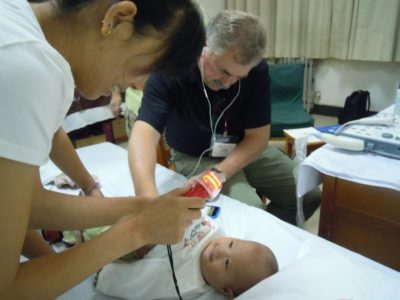A Pediatric Cardiologist from West Virginia Practices Rural Medicine in China
 By Quan Ni – I first met Dr. Lee Pyles on the airplane on our trip from Minneapolis to Lanzhou, China in 2008. We were both volunteering for Children’s HeartLink, a Minnesota NGO, dedicates in medical training to fight congenital heart disease. Lee carried a giant suitcase, a roller bag, and a big backpack. Lee grew up in West Virginia, and just moved back there recently after 15 years working with the University of Minnesota. In the nine years after that initial trip, Lee and I have traveled together to Lanzhou, Huining and Linxie in Gansu, Kunming and Xixuanbanna China.
By Quan Ni – I first met Dr. Lee Pyles on the airplane on our trip from Minneapolis to Lanzhou, China in 2008. We were both volunteering for Children’s HeartLink, a Minnesota NGO, dedicates in medical training to fight congenital heart disease. Lee carried a giant suitcase, a roller bag, and a big backpack. Lee grew up in West Virginia, and just moved back there recently after 15 years working with the University of Minnesota. In the nine years after that initial trip, Lee and I have traveled together to Lanzhou, Huining and Linxie in Gansu, Kunming and Xixuanbanna China.
Dr. Pyles is a pediatric cardiologist. During the training visits, Dr. Pyles performed echocardiograms (or “echo” for short) to verify diagnostics and confirm the plan for each surgery that the Children’s HeartLink team would work on with the local team. These patient exams were like a live classroom. Lee loved to teach. No detail was too small where it was critical.
It is a constant challenge for an echo doctor in China to see up to 100 patients a day, which is easily five times the volume in the US. It is a balance of serving a high volume of patients and maintaining the quality of diagnosis for each. Lee taught from his experience of understanding physiology to help the local team improve efficiency and quality.
On the first day of each training visit, members of both teams gather for a case conference to review all candidates for surgeries during the visit. Lee and I noticed the high percentage of pulmonary hypertension among children that were initially selected by the local team. Pulmonary hypertension in children with congenital heart disease (CHD) is caused by the high-pressured blood from the left ventricle of the heart that flows through an opening that called ventricular septal defect, to the right ventricle then into the lung. A prolonged high pressure can cause irreversible damage to the lung and the heart. When diagnosed early, closing the ventricular septal defect can avoid the permanent damage to the heart and lung with a curable outcome. When not diagnosed in time, pulmonary hypertension associated with the damaged heart and lung function increases the risk during surgery and recovery and may mean the patient has missed the window for treatment altogether.
It is rare to see pulmonary hypertension among children with CHD in the U.S. and other developed countries these days. The murmurs generated by the heart defect are recognized by trained pediatricians during early childhood checkups. In a place like Gansu and Yunnan province in China, however, many children from rural areas may not see a doctor for years after birth. Lee and I have visited several rural counties in Gansu and Yunnan working with local doctors to find these children and help improve the diagnosis of CHD in rural communities. With help from, Weiguang, a software engineer, we developed a telemedicine system for health workers to record and transmit heart murmurs via smartphone for review and consultation by a heart specialist in another location. This idea was how we got started in our organization, One Heart Health, to improve access to CHD screening in rural parts of the world with medical technology solutions.
Many of the children Lee and I met in China had not seen a U.S. doctor before in their lives. Doing echo exams with their cooperation was no small feat. The young ones might bite their tongue, staring at Lee’s big nose. The infants and toddlers could cause riots. Lee could always see the trouble ahead and went to his big suitcases to fetch a toy. These made-in-China toys were big hits with the babies. Their moms were also impressed when they heard the toys were all the way from America. Lee still travels with all his suitcases whenever we go to China.



